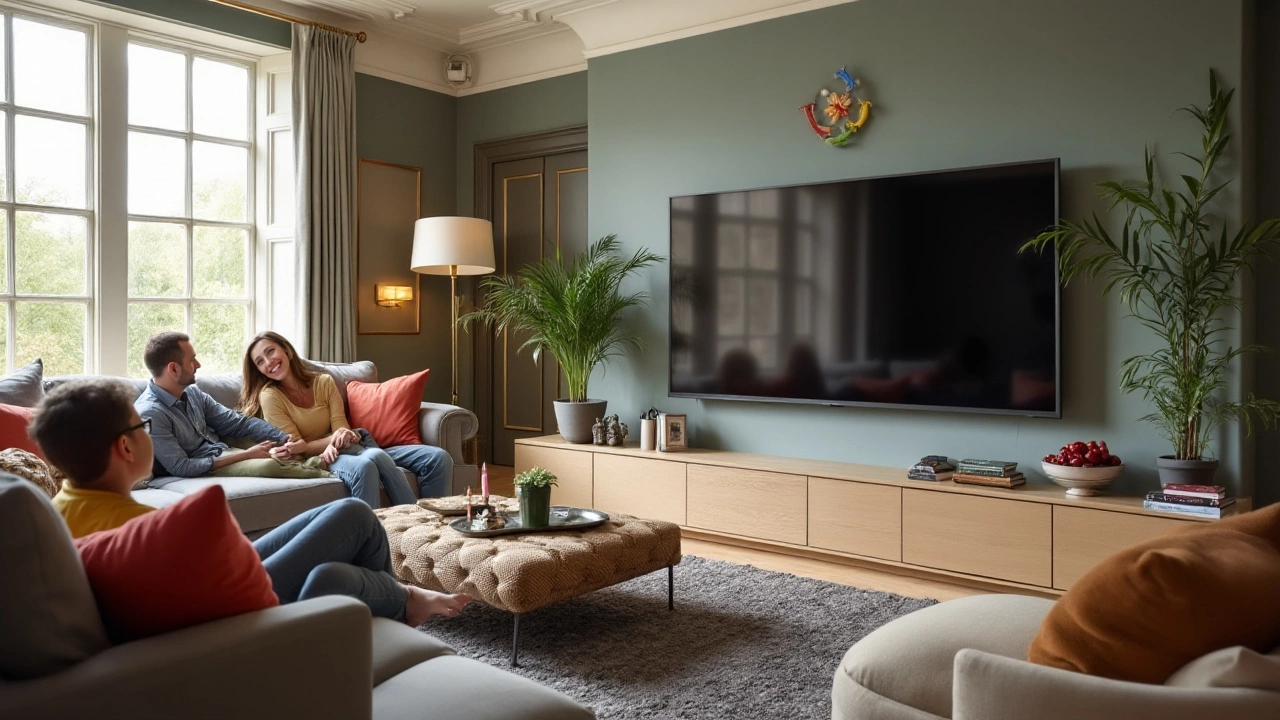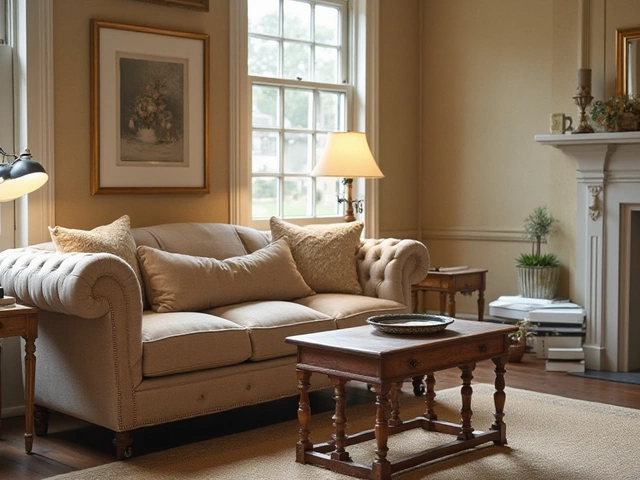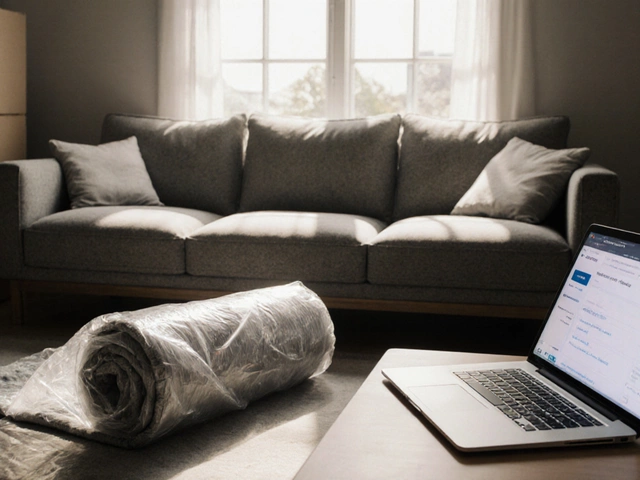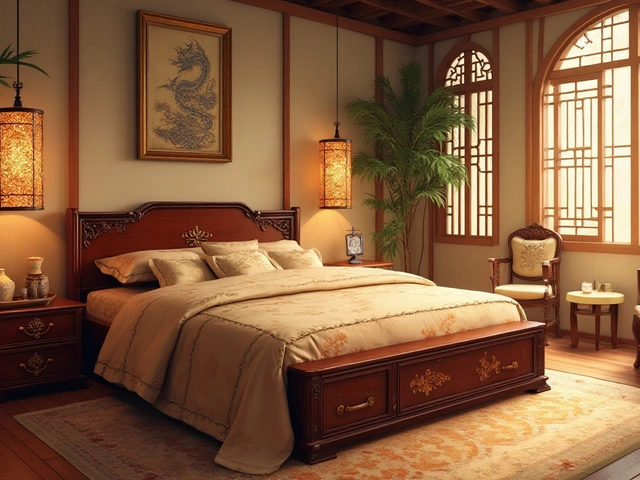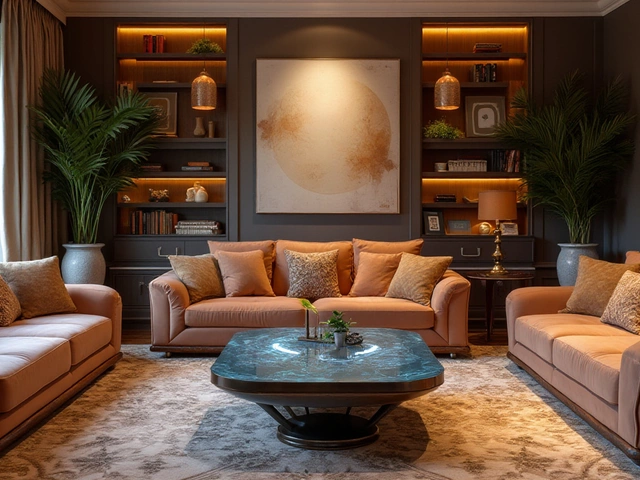Have you ever settled onto your couch and found yourself craning your neck because your TV is mounted too high? Or maybe you've noticed your screen seems just a bit too low based on your seating setup. The quest for the ideal TV height is ongoing for many home decorators and tech enthusiasts.
Choosing the right height for your TV, whether it's mounted high or low, depends on several crucial factors. Understanding these can transform your viewing experience and enhance the aesthetic appeal of your space. In this guide, you'll find insights into how viewing angles, room dimensions, and personal tastes dictate the most comfortable and practical TV placement.
- Understanding Eye-Level Viewing
- Considerations for High TV Mounting
- When Low TV Placement Works Best
- Room Dynamics and Viewing Distance
- Design and Aesthetic Implications
- Tips from Interiors Experts
Understanding Eye-Level Viewing
The concept of eye-level viewing is pivotal in creating a seamless and comfortable television watching experience. Eye-level viewing essentially means positioning your TV so that the center of the screen is perfectly aligned with your gaze when you are seated. This approach minimizes neck strain and ensures that your eyes are not working harder than they need to absorb the visuals on screen. Experts have found that the ideal height for the center of the screen is generally at or just below the eye level for the average seated adult, which can fluctuate around 42 inches from the floor, depending on the height of your furniture.
When you talk about TV positioning, this seemingly simple notion of aligning the screen to your eye line carries substantial weight. One noteworthy study by the Scientific Committee on Emerging and Newly Identified Health Risks noted that prolonged viewing of screens placed either too high or too low could potentially contribute to eye discomfort or musculoskeletal stress over time. The simple act of keeping your screen at an ideal height can thus contribute not only to better visual enjoyment but also to overall health. An improperly placed screen may cause viewers to hunch or stretch which can lead to discomfort.
Choosing the right TV wall mount height also depends greatly on personal preference and screen size. A 65-inch screen would not necessarily be placed at the same height as a 42-inch screen, due to their size differences and the resultant effect on viewing angles. Understanding the fact that viewing comfort can dictate the entire layout within your living room is crucial. This is where measuring from the floor to the bottom of the TV before mounting is invaluable. Pictures can deceive when it comes to achieving the optimal viewing height, hence the importance of a measuring tape.
Viewing comfort also ties into an individual's lifestyle, which varies greatly from household to household. A room dedicated to movies might call for an entirely different setup than one tailored towards everyday television watching or video gaming. Viewing distance plays a role here, as it can dictate how high a screen should be. Proper viewing distance ensures that the screen can occupy the right field of vision, without causing eye fatigue. It's about crafting a space that allows you to immerse yourself into content without consciously feeling the physical strain.
"An optimal viewing experience can substantially enhance the enjoyment of both movie time and daily viewing," says Dr. Eleanor Cunliffe, an ergonomics specialist who often speaks on the relationship between screen time and physical well-being. "It comes down to positioning your screen to suit your body's natural posture and range of motion."
Ultimately, the true magic lies in balancing your personal watching habits with ergonomic recommendations. This balance ensures a healthier, more enjoyable interaction with your TV, validating the old adage that comfort truly is key. As the evolution of home spaces continues, understanding how to incorporate functional, comfort-centric design around screens is more prominent than ever. By recognizing the importance of eye-level viewing, you can orchestrate a viewing area that not only looks good but feels good too.
Considerations for High TV Mounting
Mounting your TV high on the wall can be both a stylistic choice and a necessity depending on your living space configuration. There are several factors to consider if you're thinking about placing your TV above the standard eye level. First and foremost, it's important to consider the potential impact on your viewing comfort. When placed too high, prolonged TV viewing may cause neck strain, as you might find yourself having to constantly look up. Ideally, the center of your TV screen should be at eye level, a principle frequently emphasized by designers and ergonomics experts alike.
There's also the matter of room aesthetics and functionalities. A high TV placement can often complement a feature wall or integrate seamlessly with mounted artworks or a fireplace. It creates a contemporary and sleek look that many homeowners desire. However, keep in mind the practical aspect; with a higher mount, there could be glare issues from overhead lighting or windows, which must be addressed with careful planning. Designing a space that combines style with practicality requires balancing these competing factors meticulously.
Beyond comfort and aesthetics, height considerations should also be attentive to screen size and distance from seating. For larger TVs, a higher mount might be more justified, as the larger screens naturally draw your line of sight upwards. Conversely, smaller screens might get lost if mounted too high, diminishing the viewing experience. A helpful guideline suggested by the Society of Motion Picture & Television Engineers is that viewers sit back from the screen at a distance of 1.5 to 2.5 times the screen's diagonal length. This translates into optimal immersive viewing without feeling overwhelmed or strained.
It's equally important to consider the type of mount used for high installation. Tilting wall mounts can come in handy, allowing the screen to angle downward slightly, aligning better with a seated viewer's eye level. This small adjustment can alleviate discomfort significantly. Be sure your wall mount is securely installed, ideally by professionals, taking care of the weight and wall material to prevent any unfortunate accidents.
"A TV mounted at a high level can elevate the sophistication of your space," remarks Jane Morgan, an award-winning interior designer. "But it's vital to mix aesthetics with practicality to ensure a personalized and comfortable setting."
As you explore high TV placement, another critical factor is wiring and cable management. High mounts often lead to longer visible cable runs unless concealed carefully behind drywall or through cable management systems. Therefore, plan your wiring and power outlets accordingly, possibly with the aid of a professional. The advent of wireless technology and streaming devices has alleviated some of these concerns, allowing for a clean setup with minimal visible clutter.
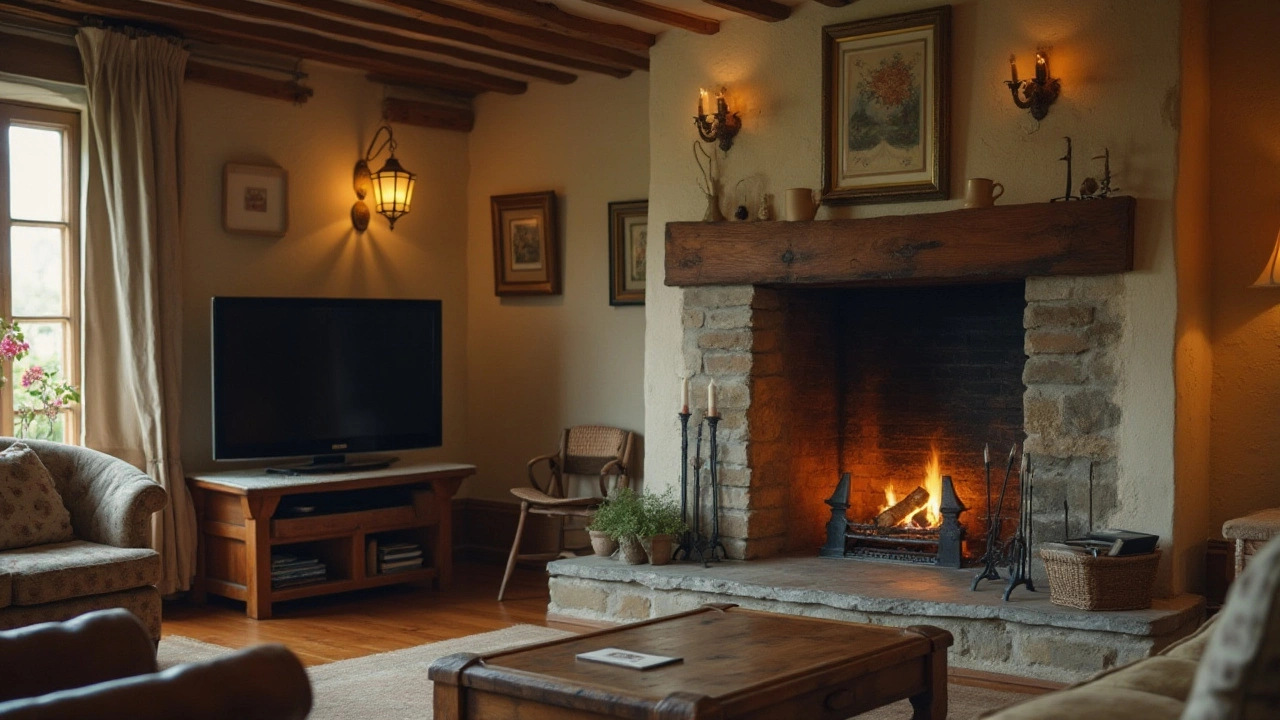
When Low TV Placement Works Best
Mounting your TV closer to the floor can seem counterintuitive with all the buzz surrounding high wall mounts. Yet, for many home environments and layouts, a lower placement might just be the perfect fit. Think about those long, cozy nights slumped into the plush couch or reclined lazily in that bean bag chair. A low TV placement keeps the screen within the natural line of sight, providing a comforting and inviting feel. This setup is particularly beneficial in rooms where folks might be seated on cushions or lower furniture, such as a bedroom or a small family room where relaxed sitting positions dominate.
Using a lower placement also opens up a variety of creative interior design opportunities. Imagine a feature wall studded with artwork or shelves above the screen, allowing the television to seamlessly blend with the decor rather than stand as the focal piece. This can relieve rooms from feeling like mini-cinemas and instead support multipurpose use of the space. Such arrangements allow the TV positioning to support varied leisure activities without dominating the room's aesthetic. Lower mounts are especially common in households with children or pets, where heavy furniture pieces cover electrical outputs and furniture decor options maximize utility and safety.
From a technical perspective, you might notice that lower placements can improve viewing comfort if the screen size is proportionate to the distance from seating. Here’s a handy tip: the center of your TV should ideally be at or just below eye-level when you're in your usual viewing spot. This avoids tilting your head up, which can strain the neck over prolonged periods. According to the Society of Motion Picture and Television Engineers (SMPTE), the optimum TV height allows for a viewing range where your line of sight is straight-on without requiring upward gaze.
"Finding the right TV height is an intricate blend of art and science," says interior designer Thomas O'Brien. "The goal is to craft a room that feels welcoming and comfortable and also functions well for television viewing."
When choosing the best position, you may also want to consider the dynamic of the entire room, including reflective surfaces and sources of natural light which often betray high mounts with glare. Low mounts often help circumvent these issues, providing a clear and enjoyable viewing experience irrespective of where the windows might be located. Small curiosities or low-centered decor nearby also heed inspiration to fill spaces creatively. As more homes lean towards open-plan living, these considerations help balance the livable luxury many seek today.
| Parameter | Recommendation |
|---|---|
| Eye Level | Centered or slightly below |
| Room Use | Casual, family settings |
| Lighting Considerations | Less prone to glare |
These factors highlight the flexibility and advantages of low-TV placement. So, next time you're setting up that new TV, give a thought to an understated, yet comfortable low mount—it just might make watching that favorite show even more enjoyable.
Room Dynamics and Viewing Distance
Creating the perfect setup for your TV means considering the dynamics of the room where it's housed. The mantra for ideal TV placement centers around understanding the relationship between viewing comfort and room size. This dynamic affect not only how your favorite shows look, but also how easy it is on the eyes. The size of your room plays a surprisingly pivotal role in dictating where your TV should be mounted. A large, expansive living room may call for a different strategy than a cozy den, meaning that the decision on whether your TV wall mount should be high or low is far from arbitrary. To understand this better, think about perspective views. If your room has high ceilings and you mount your TV too low, it can all but disappear from certain angles.
The question of viewing distance is closely tied to resolution, another critical element. As screen resolution increases, the optimal viewing distance decreases. For instance, if you own a full HD TV, the recommended distance is about 1.5 to 2.5 times the diagonal screen size. Interestingly, for a 4K ultra HD TV, this distance decreases, bringing viewers closer to the details. This means that people sitting at different corners of your room will have starkly different experiences if the TV is mounted incorrectly. The positioning of seats, pathways, and windows should all come into consideration, working hand in hand to reduce glare and ensure comfort.
Equally important is considering the height of the furniture in the viewing room. The modern style often includes lower seating arrangements, dictating that TVs should also be nestled lower to align with the typical line of sight. Many experts recommend mounting the TV such that its center is eye-level when you are comfortably seated. Television is a participatory medium, not a craning exercise. If you have a sectional sofa, for example, every seat should ideally face the TV at the same elevation for consistent viewing quality.
The American Optometric Association advises, "To lessen strain, the center of the screen should sit about 15 degrees below your eye level."Based on this thought, it becomes apparent how indiscriminate placement can acutely affect your viewing pleasure.
Sometimes, useful data like room dimensions can be helpful. Here's a short guide:
- For TVs up to 32 inches: 4-6 feet of distance.
- For TVs between 32-47 inches: 6-10 feet of distance.
- For TVs larger than 47 inches: 10 feet or more.
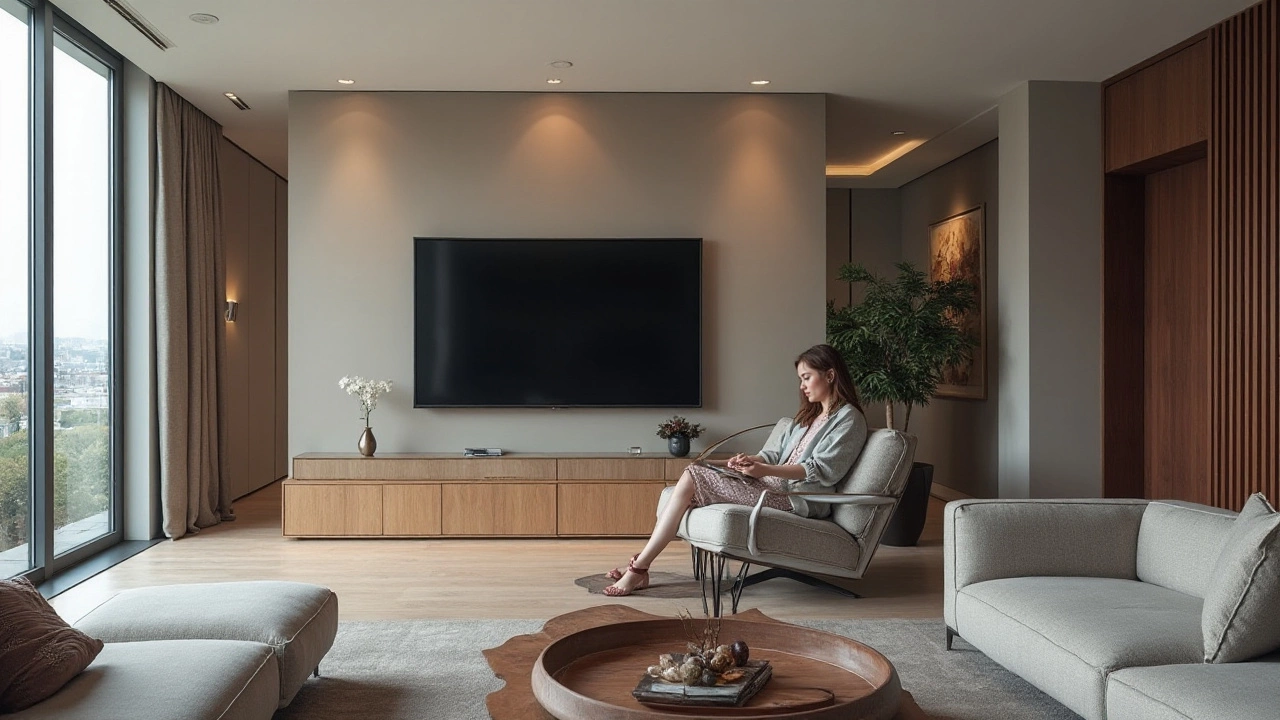
Design and Aesthetic Implications
When it comes to mounting your TV, design and aesthetic implications play a significant role in the decision-making process. Perhaps you've spent considerable time curating a living room ambiance that reflects your style, only to find your TV placement sticking out like a sore thumb. Proper positioning can either complement your existing decor or become a jarring focal point that disrupts the flow of a room. The trick is to ensure your TV doesn't overshadow your interior design goals but rather integrates harmoniously. This involves considering the TV positioning in relation to other elements such as artwork, furniture, and even lighting fixtures that contribute to the room's mood.
Consider the role your TV wall mount height plays in visually balancing a space. A TV mounted too high might give the impression of a sports bar setting, potentially clashing with a cozier or more refined space. On the other hand, mounting it too low can create a modern vibe but might not suit more traditional aesthetics. To strike a perfect balance, interior designers often suggest aligning the bottom of the TV with the eye level of a seated viewer, allowing it to connect subtly with other elements like mantels or shelves.
"A well-placed TV should feel like an integral part of the room, not an afterthought," says Emily Henderson, a renowned interior stylist.
The size and layout of your room also influence the best placement height. In large, open-space living areas, a higher mount can make the TV visible from multiple vantage points. This is useful if your living space is designed for entertainment or frequently hosts more than just a few viewers. On the flip side, a lower mount works well for intimate rooms where people are seated closer together, offering a more personal viewing experience. Sometimes creativity is needed, especially if you have unconventional furniture arrangements. For instance, mounting the TV within a custom-designed wall unit or incorporating it into built-in cabinetry can enhance your room’s polished look. Such setups can help blend the screen with the surroundings seamlessly.
Aesthetic considerations do not stop at the height of the placement; the viewing comfort the setup delivers plays its part too. Viewing angles are more than just about comfort; they're an essential aspect of how design meets functionality. Misaligned angles could lead to screen glare and impair the rich detail of the content you're watching. Avoiding situations where direct sunlight hits the screen or opting for anti-glare screens can enhance both the aesthetic appeal and the usability of your TV placement. Additionally, digital design elements like smart TVs with thin bezels can elevate the look, reinforcing a minimalistic, unobtrusive impact. Finally, always think about wire management, which, when poorly executed, can spoil the aesthetics entirely, regardless of how strategically you’ve mounted the TV.
Tips from Interiors Experts
When it comes to mounting your TV, getting advice from interior design experts can be invaluable. These professionals aren't just about making your home look good; they blend style with practicality. One of the key tips from the pros is to first evaluate the primary purpose of your room. Is it more social, like a living room, or is it a dedicated media area? For a TV positioning that suits a social living space, keeping the TV at the eye level when seated helps maintain an inviting atmosphere. Experts often suggest keeping the center of the screen just above eye level, around 42 to 48 inches from the floor, creating an enjoyable viewing experience without craning necks or squinting eyes.
Interior designers also highlight the importance of balancing seating distance with TV size. A rule of thumb often seen in practice involves ensuring the viewing comfort by having a distance from the TV that is about 1.5 to 2.5 times the diagonal screen size. This not only prevents eye strain but also keeps larger sets from overwhelming the space they occupy. Designers frequently recommend measuring your room and the prospective seating layout before deciding on the size and TV wall mount height, suggesting that these calculations can make all the difference in both comfort and room dynamics.
Placement can also affect the overall aesthetic feel of the room. According to many experts, such as those at HGTV, lighting plays a significant role in this. "Avoid mounting the TV on walls with windows that allow direct sunlight," recommends a feature on their site. This tip helps in avoiding glare and reflections, ensuring a better screen visibility without the need for constant adjustment of drapes or blinds. Combining this insight about lighting with clear visual lines throughout the room creates an uninterrupted flow, adding to your interior’s charm without the TV being a jarring focal point.
Statistical data from the Consumer Electronics Association suggests that many homes in the U.S. now opt for larger TVs as prices have decreased over the years. With this trend, interior experts advise to also consider not just the height but the stability and correct installation of your mount. Using a reliable mounting bracket is crucial for ensuring the TV stays secure on the wall. An incorrectly mounted television can pose a safety risk, especially in homes with children or pets who might have accidental contact with the setup.
In practice, interior designers often recommend a process involving a visual walkthrough. Start by placing placeholder markers on your wall at varying TV wall mount heights and viewing them from different angles within the room. This hands-on approach provides a better sense of how the TV will look and feel once mounted. Don't rush this step, as the visual alignment will impact not only the viewing experience but also the social interactions within the room, keeping the flow harmonious and the technology integration seamless.
